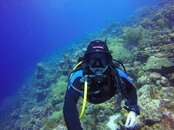Would you be happy diving with it on a buddy?
As described, no. For several reasons:
1. It is - from my perspective - inefficient.
2. It does NOT facilitate 'primary donate', which I have come to accept as the best possible configuration, and best possible approach in an OOA situation.
Basically, I do not agree with your subsequent statement that, 'pushing primary donate on a rec diver with no experience or training might increase stress levels in an emergency'. In fact, I think that is a very likely scenario (that they will go for what is in your mouth), so why not make it as easy as possible for them to take the reg that: a) they can readily see, b) they can easily access, and c) you know is working, at the moment they need it (because YOU have been breathing from it immediately before).
And, it is easy to configure a 'standard' hose length system (if there is such a thing as 'standard' lengths) to meet those objectives. Simply use the second stage on your longer, 40" hose as your 'primary'. Use the second stage on your shorter (32-36") hose as your alternate, positioned for YOUR ready use on a bungee necklace. The OOA diver sees and takes what is in your mouth (good), or you
actively donate what is in your mouth (better) on a manageable 40" hose, and you immediately go to your alternate on the shorter (32-36") hose that is on the bungee.
You can make it even easier for the OOA diver. Make the primary more visible: if your (formerly alternate) second stage hose is yellow, great. If your (formerly alternate) second stage has a yellow purge cover / housing, great. This system conforms to any interpretation of the PADI system - the second stage that the OOA diver is to use is in the 'triangle', at the very top in fact. There is nothing in the PADI standards or recommendation that prohibits 'primary donate'. In fact, PADI currently recommends 'active donation' of a second stage to an OOA diver - no more sitting back with your arms outstretched waiting for the poor OOA diver to find the alternate.
Two considerations apply, however. 1) if the (formerly alternate) second stage that is now the primary is a cheap, needlessly detuned, poor breathing second stage, you may want to change it out - after all, it is what you are now breathing from except when sharing air with another diver. I use identical second stages for both primary and alternate, so it isn't an issue. 2) I find a 70 degree adapter (rather than a 90) to be a bit more functional for use.
This approach definitely meets your goal of streamlining. It does not make 'both regs available and visible for take or donate'. But, I see no need for that. If the primary is the second stage that is primarily visible (OK, bad pun) to an OOA diver, there is no need for the alternate, under your chin, to be available for donation, or for an OOA diver to grab. That one is for you. Therefore, I slightly disagree with the one aspect of the configuration that Lamar shows in the video tbone linked - it makes no sense to have the yellow purge cover on the alternate second stage under the chin. It is better positioned on the one in your mouth.




